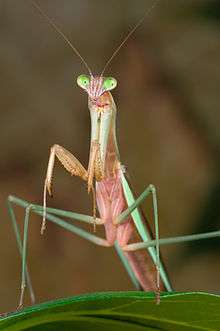Tenodera
Tenodera is a genus of mantis in the subfamily Mantinae of the family Mantidae which contains several species of praying mantises. The species in this genus can be found in North America, Asia, Africa, Australia.[1]
| Tenodera | |
|---|---|
 | |
| Adult male Tenodera sinensis | |
| Scientific classification | |
| Kingdom: | Animalia |
| Phylum: | Arthropoda |
| Class: | Insecta |
| Order: | Mantodea |
| Family: | Mantidae |
| Tribe: | Tenoderini |
| Genus: | Tenodera Burmeister, 1838 |
| Type species | |
| Mantis fasciata (Olivier, 1792) | |
| Species | |
| Synonyms | |
| |
Description
Specifically, mantids in this genus can be identified by their mid and hind femora which contain an apical spine.
Species
- Tenodera acuticauda (Yang, 1997)
- Tenodera angustipennis Saussure,1896 (Narrow-winged mantis)
- Tenodera aridifolia (Stoll, 1813) (Japanese giant mantis)
- Tenodera australasiae (Leach, 1814) (Purple-winged Mantis)
- Tenodera blanchardi (Giglio-Tos, 1912)
- Tenodera brevipennis (Saussure, 1871)
- Tenodera capitata (Saussure, 1869)
- Tenodera caudafissilis (Wang, 1992)
- Tenodera chloreudeta (Burmeister, 1838)
- Tenodera costalis (Blanchard, 1853)
- Tenodera equatoriana (La Greca, 1993)
- Tenodera fasciata (Olivier, 1792)
- Tenodera gambiensis (Beier, 1931)
- Tenodera herbacea (Serville, 1839)
- Tenodera houyi (Werner, 1928)
- Tenodera intermedia (Saussure, 1870)
- Tenodera iringana (Giglio-Tos, 1912)
- Tenodera nimbana (Roy, 1963)
- Tenodera parasinensis (Otte & Spearman, 2004)
- Tenodera philippina (Beier, 1929)
- Tenodera rungsi (Uvarov, 1935)
- Tenodera sinensis (Saussure, 1871) (Chinese Mantis)
- Tenodera stotzneri (Werner, 1929)
- Tenodera superstitiosa (Fabricius, 1781)
gollark: hahahahahahahaaahahahahahahahhahahaahahhahahhhahahahahahahhhahhhhhhhhhhhahahha again.
gollark: I mean, if you don't care about customizability or tracking or not randomly breaking, *maybe*?
gollark: It's open source and verifiably does not track me (significantly).
gollark: Some apps are annoying without it?
gollark: microG works surprisingly well, too.
See also
Sources
External links
This article is issued from Wikipedia. The text is licensed under Creative Commons - Attribution - Sharealike. Additional terms may apply for the media files.